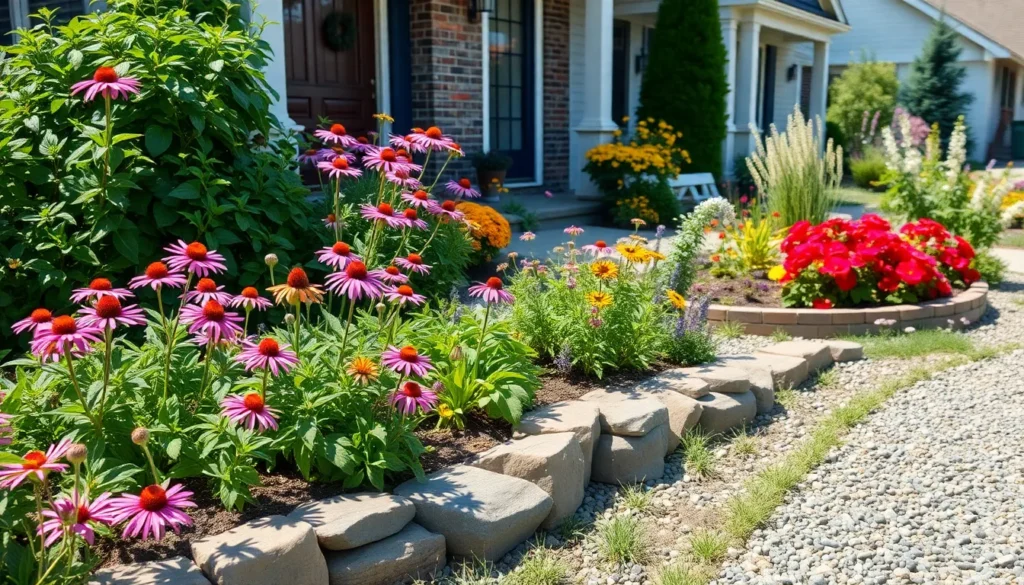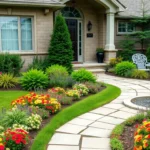We’ve all driven past those stunning front yards that make us slow down and admire their beauty. The manicured lawns, perfectly placed flowers, and elegant hardscaping create an irresistible curb appeal that transforms an entire neighborhood. But what if we told you that achieving this magazine-worthy look doesn’t require very costly?
Creating a breathtaking front yard on a budget isn’t just possible – it’s easier than you think. With the right strategies and a bit of creativity, we can help you transform your outdoor space without spending thousands of dollars. From clever plant selections to DIY projects that pack a visual punch, there are countless ways to maximize your landscaping budget.
Whether you’re looking to boost your home’s value, impress the neighbors, or simply create a welcoming entrance for your family, we’ll show you how to achieve professional-looking results with wallet-friendly answers that won’t compromise on style.
Create a Stunning Entrance With Low-Cost Native Plants
Native plants offer the perfect solution for budget conscious homeowners seeking maximum impact with minimal investment. We’ve discovered that local species naturally thrive in your area’s climate while requiring significantly less water and maintenance than exotic alternatives.
Choose Drought-Resistant Local Species
Local nurseries provide the best selection of drought tolerant native plants that flourish in your exact region. We recommend visiting your county extension office to obtain a free list of indigenous species like purple coneflowers, black eyed Susans, and ornamental grasses that require minimal watering once established.
Research shows that native plants use 50% less water than non native varieties while providing superior drought resistance during dry spells. We’ve found that species like lavender, sage, and native sedums create beautiful focal points while surviving on natural rainfall alone after their first growing season.
Contact your local botanical garden for recommendations on the most cost effective native plants that deliver stunning visual impact. Many regions offer native plant sales during spring and fall seasons where we can purchase healthy specimens at wholesale prices.
Group Plants by Water and Sun Requirements
Strategic plant grouping reduces water waste while creating visually cohesive garden zones that require similar care routines. We organize our front yard layouts by placing drought loving plants together in sunny areas and moisture preferring species in shadier spots.
Sun loving natives like butterfly weed and native grasses thrive when planted together in south facing areas that receive 6-8 hours of direct sunlight daily. We’ve discovered that grouping these heat tolerant plants creates natural water conservation zones that virtually maintain themselves.
Shade tolerant native species such as coral bells, wild ginger, and native ferns flourish when clustered under trees or along north facing walls. This zoning approach eliminates the need for complex irrigation systems while ensuring each plant receives optimal growing conditions.
Start With Perennials for Long-Term Savings
Perennial native plants provide the greatest return on investment since they return year after year without replanting costs. We prioritize purchasing hardy perennials like native asters, goldenrod, and prairie dropseed that multiply naturally and can be divided to create additional plants.
Investment in quality perennial natives pays dividends through natural self seeding and spreading characteristics that fill empty spaces over time. We’ve calculated that spending $100 on perennial natives during the first year creates $500 worth of established plantings within three growing seasons.
Many perennial natives produce seeds that we can collect and plant in new areas, essentially providing free plants for future landscaping projects. Species like rudbeckia and native milkweed readily self sow while attracting beneficial pollinators that enhance the entire garden network.
Design Eye-Catching Pathways Using Affordable Materials

Creating beautiful walkways doesn’t require expensive materials when you know the right techniques. We’ll show you three budget-friendly methods that transform your front yard’s accessibility and visual appeal using readily available materials.
Build Gravel Walkways With Edging
Gravel walkways offer exceptional value for budget-conscious homeowners seeking durable pathway answers. We recommend starting with pea gravel, which provides excellent texture and drainage while staying contained within proper edging.
Installation process:
- Mark your desired path using spray paint or rope
- Install metal or plastic industry edging to contain the gravel
- Lay industry fabric across the pathway to suppress weeds
- Pour pea gravel evenly and rake smooth
This method creates neat, professional-looking walkways that enhance both accessibility and curb appeal. Metal edging provides the most durable containment, while plastic strips offer a more budget-friendly alternative that still delivers excellent results.
Create Stepping Stone Paths With Concrete Pavers
Concrete pavers deliver outstanding durability and attractive appearance without breaking your landscaping budget. We’ve found that placing pavers directly on level ground creates stable stepping stone paths that can be completed in a single weekend.
Installation process:
- Arrange pavers at comfortable walking intervals (typically 18-24 inches apart)
- Level each paver using a rubber mallet and checking tool
- Fill gaps between pavers with mulch or decorative gravel
- Compact surrounding soil for additional stability
Stepping stone designs require minimal digging compared to traditional walkways, making them perfect for DIY installation. The versatility of concrete pavers allows you to create curved or straight paths that complement your home’s architecture.
Use Mulch Borders to Define Walking Areas
Mulch provides the most economical solution for defining pathways while adding natural texture to your industry design. We suggest using organic mulch around stepping stones or as standalone pathway borders to highlight walking routes effectively.
Installation process:
- Edge the pathway area using a spade or edging tool
- Spread mulch evenly to a depth of 2-3 inches
- Rake smooth and shape borders as desired
- Plan for annual refreshing to maintain appearance
This approach prevents weed growth along walkways while creating clear visual boundaries between planted areas and foot traffic zones. Organic mulch breaks down over time, enriching the soil and supporting nearby plant health throughout the growing season.
Transform Your Space With DIY Garden Beds and Borders
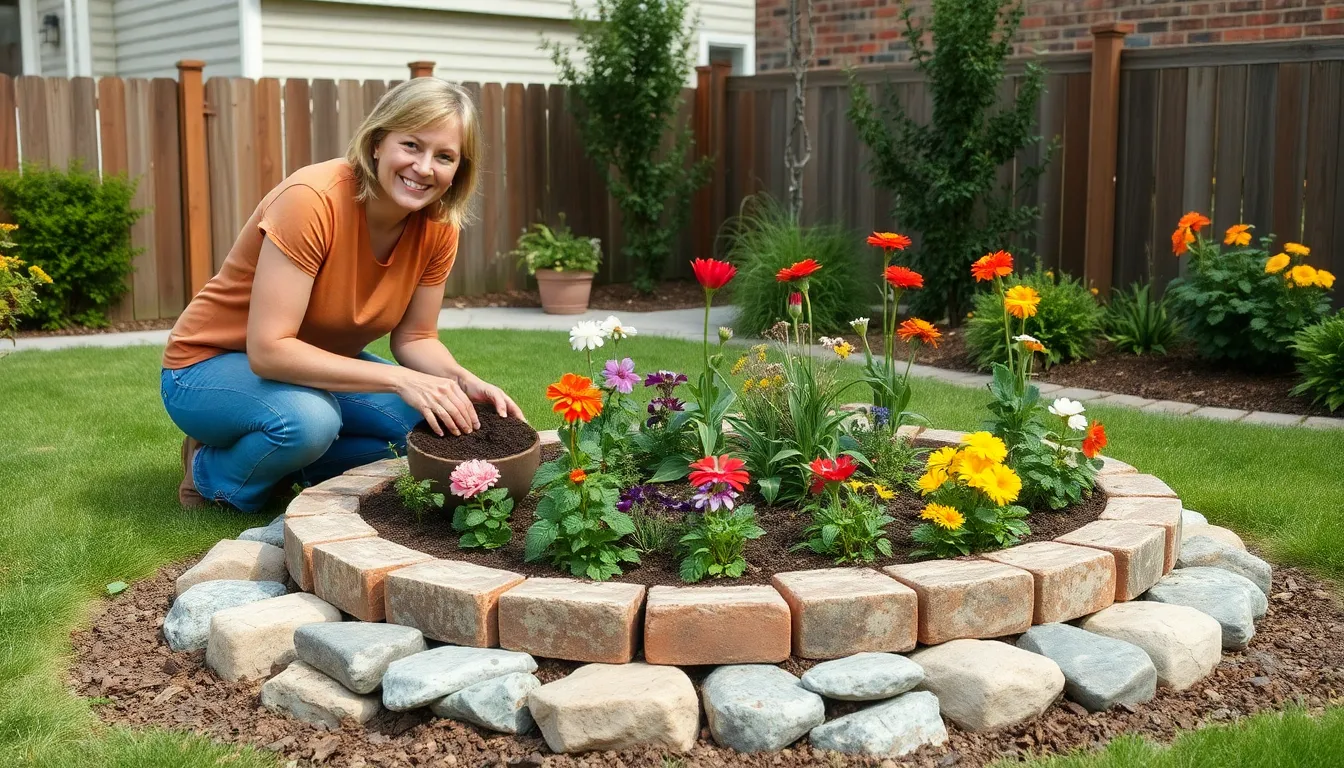
Building well-defined garden beds and borders creates structure in your front yard while keeping costs low. These DIY projects require minimal investment but deliver maximum visual impact for budget-conscious homeowners.
Construct Raised Beds Using Recycled Materials
Raised beds become affordable when we use recycled materials like old bricks, rocks, or wine bottles for construction. These repurposed items add unique character to your yard while keeping expenses minimal. Building with recycled materials helps define planting areas and improves soil conditions for healthier plant growth.
Wine bottles can be buried neck-down to create colorful borders that catch sunlight beautifully. Old bricks from construction sites or demolition projects work perfectly for sturdy bed walls. Rocks collected from your property or sourced locally provide natural texture that complements any landscaping style.
Construction requires basic tools and can typically be completed within a weekend timeframe. Stack materials to your desired height, usually 12-18 inches for optimal drainage and root development. Fill the completed beds with quality soil mixed with compost for the best growing conditions.
Edge Gardens With Natural Stone or Brick
Natural stones and bricks create polished borders that define flower beds and pathways effectively. This inexpensive technique adds professional appearance to your garden while keeping mulch and soil properly contained. Local suppliers often offer affordable options, and leftover construction materials can be repurposed for important savings.
Installing stone or brick edging requires digging a shallow trench along your desired border line. Place stones or bricks flush with the ground level to prevent tripping hazards while maintaining clean lines. Backfill around the materials with soil to secure them in position.
Curved borders work well with smaller stones that can follow natural industry contours. Straight pathways benefit from uniform brick placement for geometric precision. Both options provide long-lasting answers that require minimal maintenance once properly installed.
Install Simple Retaining Walls for Dimension
Low retaining walls using stacked stone, concrete blocks, or timber add visual interest while managing sloped areas efficiently. These structures create tiered garden beds that improve both aesthetics and drainage throughout your industry. Small DIY retaining walls can be completed affordably using recycled or budget-friendly materials.
Stacked stone walls provide natural beauty and excellent drainage without requiring mortar for heights under 3 feet. Concrete blocks offer uniform appearance and easy installation with interlocking designs. Timber walls create rustic charm using pressure-treated lumber that resists weather damage.
Building begins with leveling the foundation area and adding a gravel base for stability. Stack materials according to manufacturer guidelines, ensuring proper drainage behind the wall structure. Backfill with gravel and soil to prevent water pressure buildup that could compromise wall integrity.
Tiered garden beds created by retaining walls allow for diverse plant selections at different elevations. Upper tiers work well for drought-tolerant plants, while lower areas accommodate moisture-loving varieties. This vertical gardening approach maximizes planting space without requiring additional ground area.
Add Vertical Interest With Budget-Friendly Structures
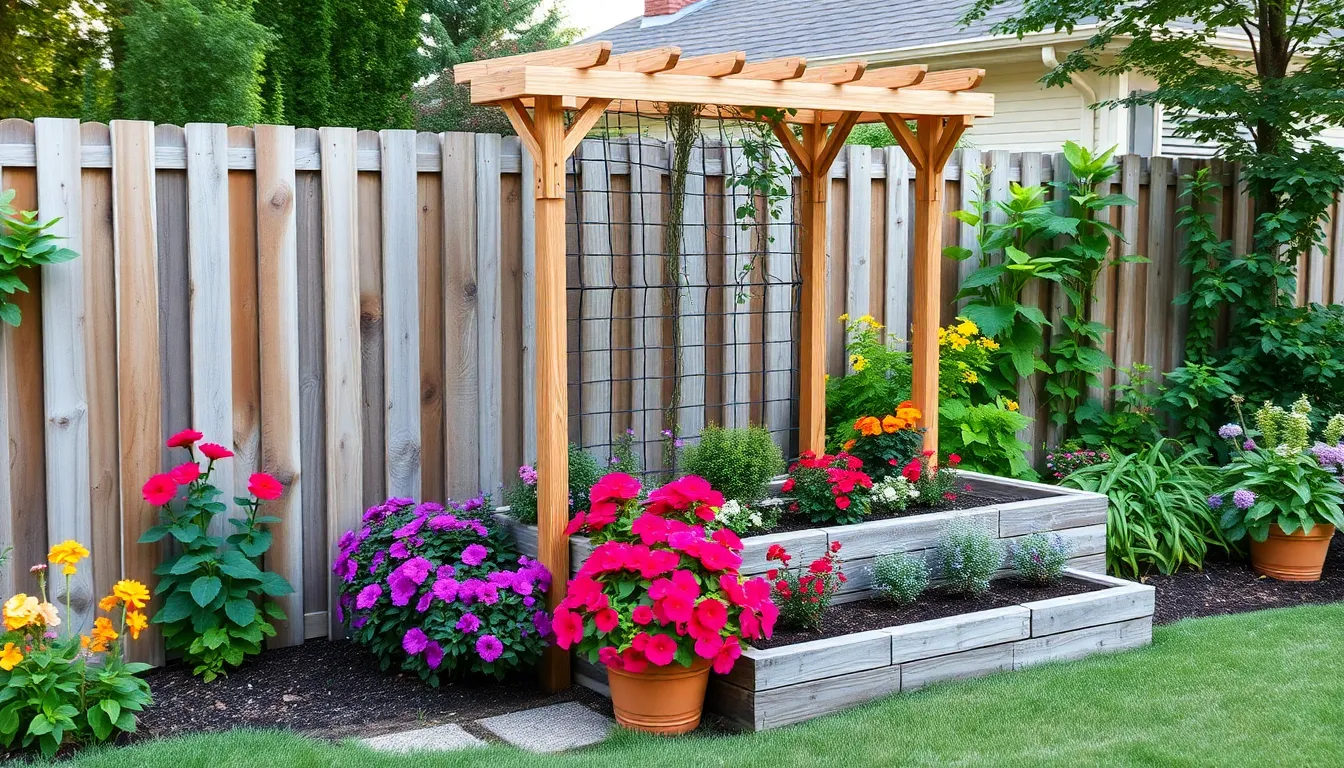
Drawing the eye upward transforms flat front yards into ever-changing landscapes without expensive renovations. Vertical elements create depth and dimension while maximizing limited space for more impactful curb appeal.
Build Trellises for Climbing Plants
Constructing your own trellises offers an affordable way to support climbing plants while adding instant height to garden beds. Wood remnants from previous projects or inexpensive lattice panels from home improvement stores provide the perfect foundation for these structures. Clematis and morning glories thrive on these supports, creating living walls of color and texture throughout the growing season.
Materials needed:
- Wood remnants or lattice panels
- Basic hardware (screws, brackets)
- Post-hole digger or shovel
Positioning trellises strategically maximizes planting space in compact yards by utilizing vertical growing areas instead of spreading horizontally. These structures serve dual purposes by providing privacy screens and windbreaks while showcasing beautiful flowering vines. Installation requires minimal tools and can typically be completed in a single afternoon.
Install Affordable Fence Panels as Backdrops
Installing basic fence panels creates attractive backdrops that enhance low beds and border plantings without major construction costs. Wooden or vinyl fence panels anchor securely to provide structure and privacy while serving as canvases for hanging baskets and climbing plants. These panels help define distinct garden zones and add a finished, professional appearance to the overall industry design.
Benefits of fence panel backdrops:
- Define garden boundaries
- Provide privacy and wind protection
- Support hanging planters and climbing vegetation
- Create visual structure at low cost
Selecting neutral colored panels ensures they complement rather than compete with colorful plantings in front of them. Anchoring systems vary based on soil conditions but generally require basic post installation techniques that most homeowners can manage independently.
Create Height With Tiered Planting Arrangements
Tiered planting arrangements maximize vertical space while creating visual depth through layered compositions of varying plant heights. Terraced flower beds or repurposed containers positioned at different elevations allow multiple plant varieties to coexist in compact areas, making landscapes appear fuller and more cohesive. Arranging taller specimens at the back and shorter ones in front mimics natural forest layering patterns that draw eyes upward.
Tiered planting strategies:
- Use terraced beds for sloped areas
- Repurpose containers of varying heights
- Position tall plants behind shorter varieties
- Create natural layering effects
Container gardening enables easy rearrangement of displays throughout seasons while providing excellent drainage for plants with exact water requirements. Combining these elevation changes with our previously discussed native plant selections and DIY garden borders creates a comprehensive vertical industry that appears professionally designed while remaining budget conscious.
Incorporate Water Features Without Breaking the Bank
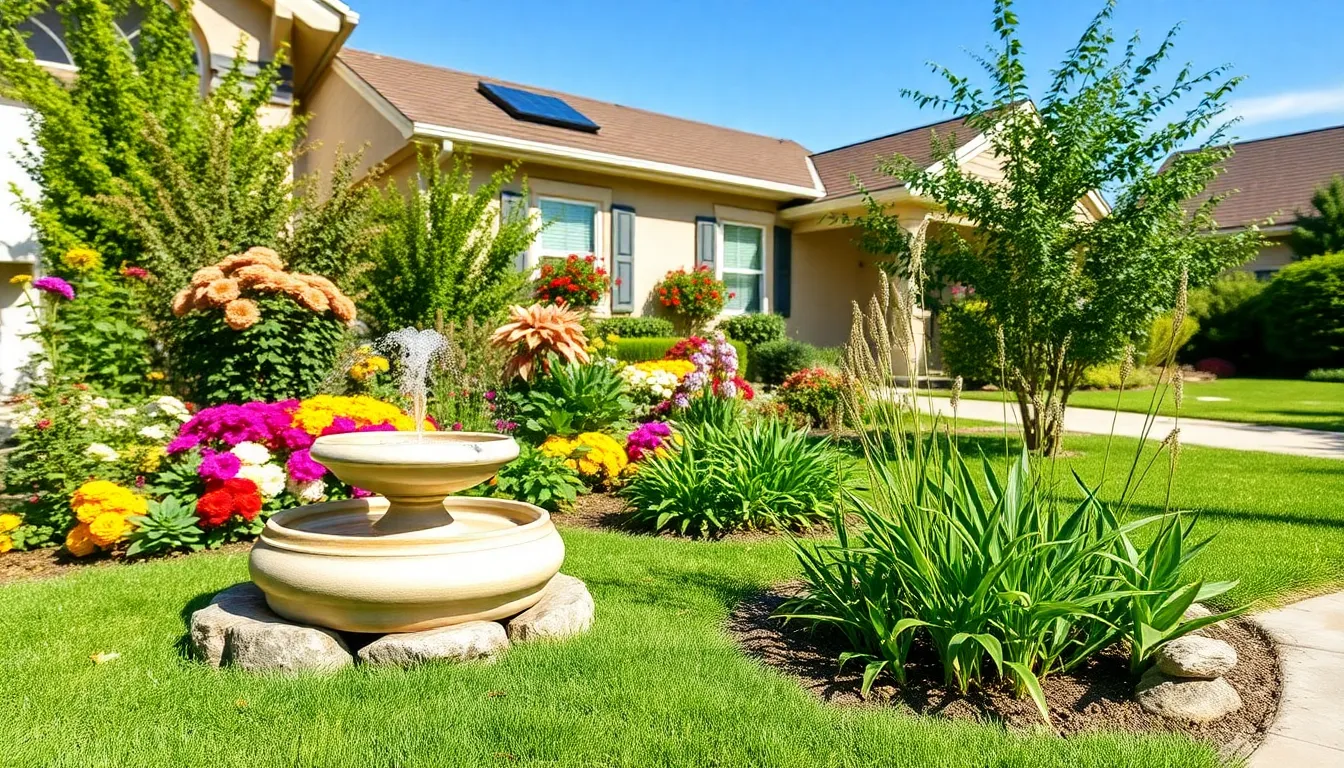
Water elements add tranquility and visual appeal to front yards while staying within budget constraints. These affordable options create soothing sounds and attract wildlife without requiring expensive plumbing installations.
Install Solar-Powered Fountain Kits
Solar powered fountains offer the perfect solution for adding moving water without increasing energy costs. These kits range from $30 to $150 and require no electrical connections since they operate entirely on solar energy. We recommend placing them in flower beds, near patios, or garden corners where they’ll receive adequate sunlight throughout the day.
Installation takes less than an hour and involves simply assembling the fountain components and positioning the solar panel for optimal sun exposure. Most kits include multiple fountain heads for different water patterns, allowing us to customize the look based on our industry design. The gentle bubbling sounds create a relaxing ambiance that masks street noise while adding visual interest to otherwise static garden spaces.
Create Rain Gardens for Natural Drainage
Rain gardens serve dual purposes by managing water runoff while creating attractive planted areas that cost virtually nothing to maintain. These shallow depressions capture rainwater from roofs, driveways, and sidewalks, preventing erosion while supporting local ecosystems. We can create effective rain gardens by selecting a low lying area of our yard and directing existing downspouts toward the space.
Native plants that thrive in wet conditions, such as cardinal flower, blue flag iris, and swamp milkweed, establish quickly and require minimal care once rooted. The initial investment involves purchasing plants and possibly adding organic matter to improve soil drainage, typically costing under $100 for a medium sized garden. These gardens naturally filter pollutants from runoff while providing habitat for birds and beneficial insects.
Build Simple Birdbaths Using Household Items
DIY birdbaths create charming focal points using materials we already have at home or can purchase inexpensively at thrift stores. Large ceramic bowls, decorative plates, or even shallow plant saucers work perfectly when mounted on sturdy bases like stacked bricks, concrete blocks, or repurposed plant stands. We can create attractive combinations by mixing textures and heights using different base materials.
The key is ensuring the water depth stays between 1 to 2 inches for smaller birds while providing shallow edges for drinking access. Adding a few flat stones or branches gives birds secure perches while creating natural looking arrangements. Total costs typically run under $25, and we can easily move these lightweight features to different locations as our industry evolves throughout the seasons.
Maximize Impact With Strategic Lighting Solutions
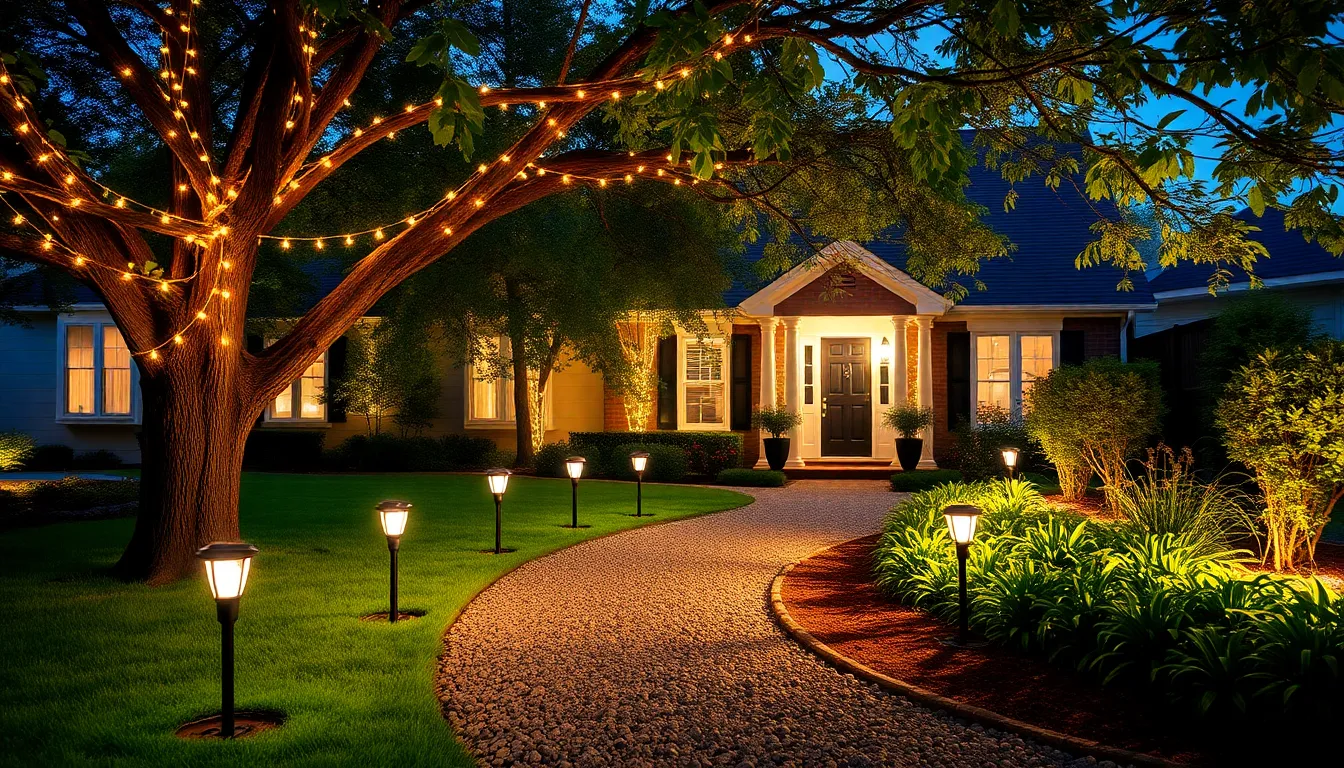
Lighting transforms front yards from ordinary to extraordinary after dark, creating welcoming entrances that enhance curb appeal significantly. We’ll explore three budget-friendly lighting strategies that deliver maximum visual impact without straining your wallet.
Use Solar Stake Lights Along Pathways
Solar stake lights offer the perfect solution for illuminating walkways without increasing electricity costs. Position these affordable fixtures every 6-8 feet along your gravel paths, stepping stone walkways, or mulch borders to create safe passage for guests while adding charm to your industry design.
Choose LED solar stakes with automatic sensors that activate at dusk and provide up to 8 hours of continuous lighting. Installation takes just minutes since these lights simply push into the ground beside your pathway edges, requiring no wiring or electrical work.
Weather-resistant models withstand rain, snow, and temperature fluctuations while maintaining consistent performance throughout the seasons. We recommend selecting warm white bulbs that complement your home’s exterior colors and create an inviting atmosphere.
Maintenance involves occasional cleaning of solar panels and replacing rechargeable batteries every 1-2 years, keeping long-term costs minimal compared to hardwired lighting systems.
Install String Lights for Ambient Glow
String lights create magical ambiance in front yards while remaining incredibly budget-friendly and versatile. Drape these lights through tree branches, along fence lines, or around porch railings to establish a warm, welcoming glow that extends your outdoor enjoyment into evening hours.
LED string lights consume 75% less energy than traditional incandescent bulbs and last up to 25 times longer, making them an economical long-term investment. Solar-powered versions eliminate electricity costs entirely while providing 6-8 hours of illumination per charge.
Installation requires basic tools like extension cords, timers, and mounting hooks or clips to secure lights safely. We suggest using outdoor-rated lights with protective coating to withstand moisture and temperature changes.
Color temperature options range from warm white (2700K) for cozy atmospheres to cool white (5000K) for modern aesthetics, allowing customization to match your home’s style and your personal preferences.
Add Uplighting to Highlight Key Features
Uplighting creates dramatic nighttime appeal by showcasing your front yard’s best assets with focused illumination. Position inexpensive LED spotlights at the base of specimen trees, architectural elements, or prominent garden beds to add depth and visual interest to your industry.
Low-voltage LED uplights consume minimal electricity while producing bright, focused beams that can highlight textures, shapes, and colors effectively. Solar-powered options eliminate electrical connections and reduce operating costs to zero.
Strategic placement involves angling lights upward at 30-45 degree angles to avoid glare while maximizing feature visibility. We recommend using warm white bulbs (2700K-3000K) to create inviting tones that complement natural materials like stone, brick, or wood.
Installation typically requires digging small holes for ground stakes or mounting fixtures to existing structures using screws and brackets. Timers and motion sensors can automate operation while conserving energy and extending bulb life significantly.
Consider highlighting multiple layers of your industry by combining uplighting with pathway illumination and string lights to create a cohesive lighting design that showcases your budget-friendly front yard improvements beautifully.
Establish Focal Points Using Repurposed and Natural Elements
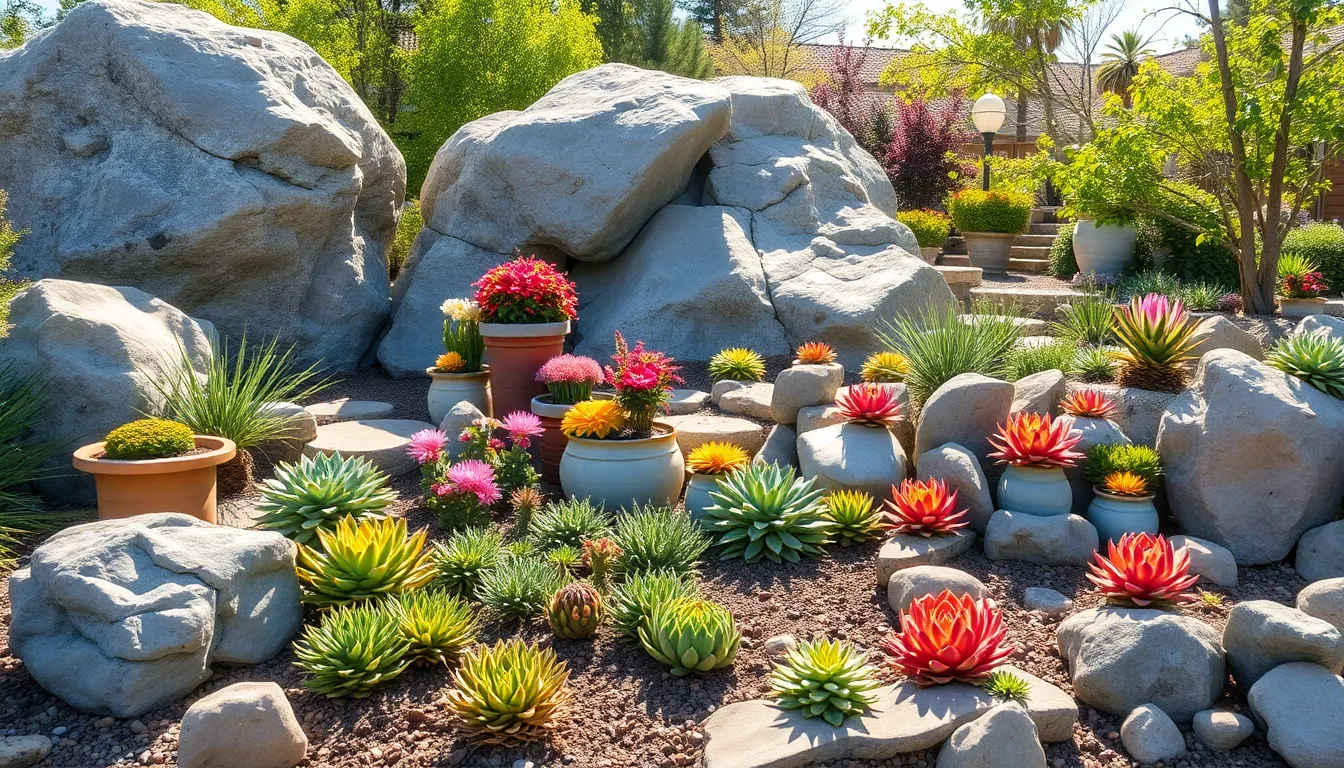
Budget-friendly front yard transformations can achieve stunning results by utilizing natural materials and repurposed items as eye-catching focal points. These sustainable approaches add character while minimizing costs and environmental impact.
Display Large Rocks or Boulders as Anchors
Large rocks or boulders serve as natural focal points that ground your industry design while requiring zero maintenance. These substantial elements create visual weight and interest without ongoing costs, making them ideal budget answers for front yard makeovers.
Combining boulders with native plants enhances their visual appeal while promoting sustainability throughout your industry. Position rocks strategically near plantings to create natural groupings that feel organic and intentional. The contrast between hard stone surfaces and soft plant textures adds depth and visual interest to your design.
Consider sourcing rocks from local quarries or construction sites where they’re often available at reduced prices. Many municipalities also offer free rock programs from road construction projects, providing homeowners access to quality materials without budget strain.
Repurpose Old Containers as Unique Planters
Old containers like buckets, crates, and vintage tubs transform into distinctive planters that add character without extra expense. This recycling approach reduces waste while creating conversation pieces that reflect your personal style and creativity.
Clean containers thoroughly before use, then add drainage holes to prevent water accumulation that could harm plants. Paint them in colors that complement your home’s exterior, or leave them natural for a rustic aesthetic that matches farmhouse and cottage styles.
Fill repurposed containers with flowers or succulents to introduce color and texture at various heights throughout your front yard. Group containers of different sizes and materials together to create ever-changing vignettes that draw attention and create visual rhythm.
Create Art Installations From Found Materials
Found materials like scrap wood, metal pieces, and discarded stones can become artistic installations that serve as compelling focal points. These creative projects leverage free resources while turning potential waste into valuable landscaping assets that showcase your artistic vision.
Create garden sculptures using weathered wood pieces arranged in geometric patterns or abstract forms. Metal components can be welded or assembled into kinetic sculptures that move with the wind, adding motion and sound to your front yard experience.
Stone arrangements create zen-like installations that provide peaceful focal points while requiring minimal maintenance. Stack stones in cairn formations or arrange them in spirals to create meditative spaces that invite contemplation and add spiritual elements to your industry design.
Maintain Your Landscape With Cost-Effective Care Strategies
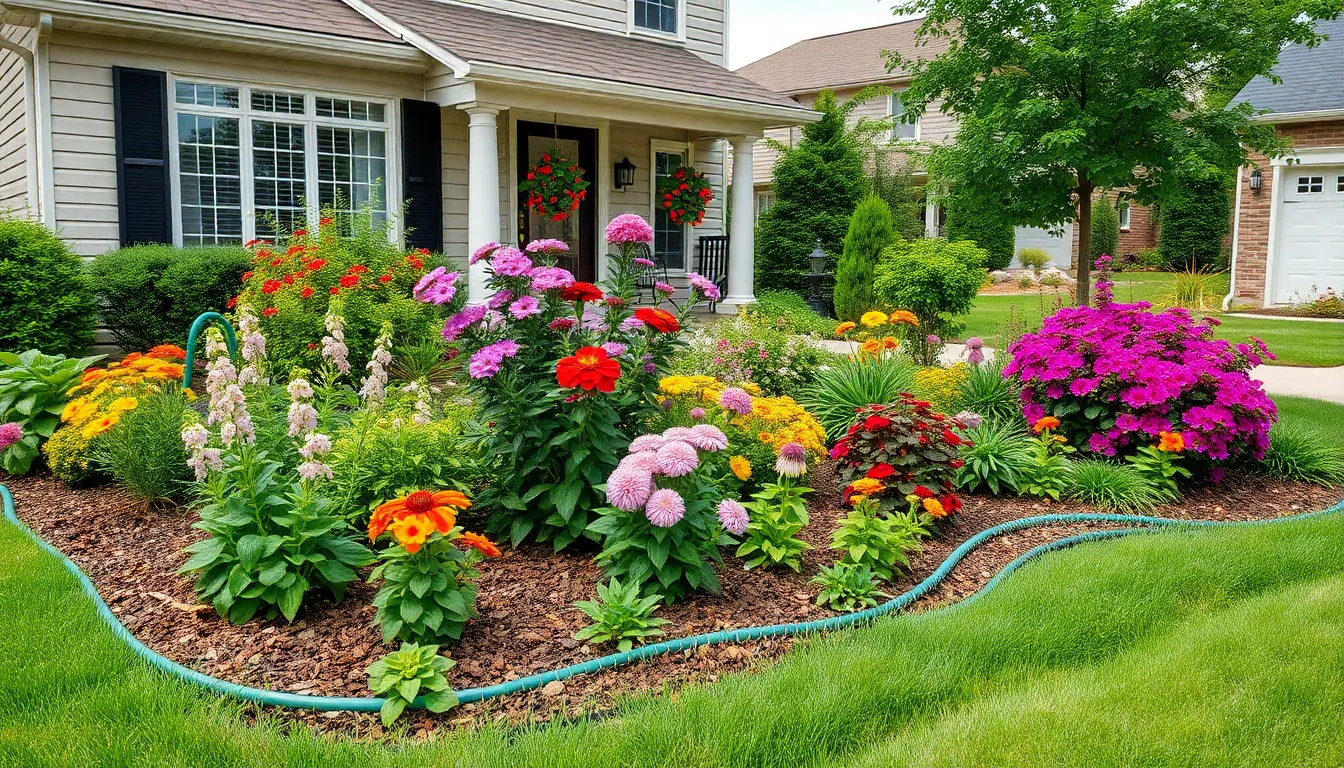
Keeping our beautiful front yard thriving doesn’t require expensive maintenance contracts or costly chemical treatments. Smart care strategies help us preserve our industry investment while reducing ongoing expenses.
Carry out Water-Saving Irrigation Techniques
Drip irrigation systems offer the most efficient way to deliver water directly to plant roots without waste. We can install basic drip systems for under $50, targeting exact garden beds and reducing water bills by up to 50% compared to traditional sprinklers.
Soaker hoses provide another budget-friendly watering solution that delivers moisture slowly and evenly along planted areas. These porous hoses cost significantly less than sprinkler systems and work perfectly for our flower beds and shrub borders.
Mulching around plants helps retain soil moisture and reduces watering frequency by creating a protective barrier against evaporation. We recommend applying 2-3 inches of organic mulch like wood chips or shredded leaves around our plantings to conserve water naturally.
Strategic plant grouping allows us to create irrigation zones based on water requirements. Drought-resistant plants like purple coneflowers and black-eyed Susans can share one watering schedule, while moisture-loving plants receive different care in separate areas.
Use Homemade Compost and Natural Fertilizers
Kitchen scrap composting transforms our food waste into nutrient-rich soil amendment without purchasing expensive fertilizers. Coffee grounds, eggshells, and vegetable scraps create excellent compost that feeds our plants naturally over time.
Yard waste composting turns fallen leaves, grass clippings, and pruned branches into valuable organic matter for our garden beds. This free fertilizer improves soil structure while reducing the need for costly commercial plant foods.
Natural fertilizer alternatives like banana peels for potassium and crushed eggshells for calcium provide targeted nutrition without chemical additives. We can also use diluted coffee as a nitrogen boost for acid-loving plants in our industry.
Compost tea brewing creates liquid fertilizer by steeping finished compost in water for several days. This gentle feeding method costs nothing to produce and provides slow-release nutrients that won’t burn our plants.
Plan Seasonal Maintenance to Prevent Costly Repairs
Spring preparation tasks include pruning dead branches, dividing overcrowded perennials, and refreshing mulch layers before the growing season begins. Early intervention prevents plant stress and reduces replacement costs throughout the year.
Summer monitoring routines help us catch pest problems and disease issues before they spread to other plants. Weekly garden walks allow us to address small problems quickly instead of dealing with expensive plant replacements later.
Fall cleanup activities like removing diseased plant material and protecting tender plants for winter prevent damage that could require costly spring repairs. Proper fall care ensures our industry investments survive harsh weather conditions.
Winter protection measures such as wrapping vulnerable plants and applying anti-desiccant sprays cost far less than replacing damaged specimens. We can use burlap screens and mulch barriers to shield our plants from wind and temperature extremes affordably.
Conclusion
Creating a stunning front yard doesn’t require a massive budget or professional landscaping services. With the strategies we’ve outlined you can transform your outdoor space using native plants DIY projects and creative repurposing techniques that deliver impressive results without very costly.
The key to success lies in strategic planning and making smart choices that provide long-term value. By focusing on perennial plants efficient irrigation systems and low-maintenance design elements you’ll create a industry that continues to pay dividends year after year.
We’ve shown you that beautiful curb appeal is within reach regardless of your budget constraints. Start with one or two projects that excite you most and gradually build upon your successes to create the welcoming front yard you’ve always envisioned.
Frequently Asked Questions
What are the main benefits of using native plants in front yard landscaping?
Native plants offer significant cost savings as they require less water and maintenance than exotic varieties. They’re naturally adapted to local climate conditions, making them more drought-resistant and hardy. Native plants also attract beneficial pollinators like bees and butterflies, supporting local ecosystems while reducing long-term gardening expenses.
How can I create attractive pathways on a budget?
Three affordable methods include building gravel walkways with pea gravel and edging for texture and drainage, installing concrete stepping stone pavers for durability and quick installation, and using mulch borders to define walking areas while preventing weed growth. All options are DIY-friendly and cost-effective.
What materials can I use for DIY garden beds and borders?
Recycled materials work excellently for raised beds, including old bricks, rocks, or wine bottles that add character while improving soil conditions. Natural stone or brick edging defines flower beds effectively, while stacked stone, concrete blocks, or timber create simple retaining walls for sloped areas.
How can I add vertical interest to my front yard affordably?
Build trellises using wood remnants or inexpensive lattice panels for climbing plants to create living walls. Install affordable fence panels as backdrops for low beds, and create tiered planting arrangements using terraced beds or repurposed containers to maximize vertical space and visual depth.
What are some budget-friendly water feature options?
Solar-powered fountain kits are affordable and easy to install, providing soothing sounds without electricity costs. Rain gardens manage water runoff using native plants that thrive in wet conditions. DIY birdbaths made from household items create charming focal points at minimal expense while attracting wildlife.
How can I effectively light my front yard without overspending?
Use solar stake lights along pathways for safety and charm, install string lights for warm ambiance, and add uplighting to highlight key landscape features. Solar-powered options eliminate electricity costs, while LED string lights provide energy-efficient illumination that creates inviting atmospheres affordably.
What low-cost materials can serve as focal points in my front yard?
Large rocks or boulders serve as natural anchors requiring no maintenance and enhance visual interest when paired with native plants. Repurpose old containers as unique planters for added character and color. Create art installations from found materials like scrap wood and metal for compelling, creative focal points.
How can I maintain my front yard landscape cost-effectively?
Install drip irrigation systems and soaker hoses to reduce water bills significantly. Use mulching to retain soil moisture and group plants strategically for efficient watering. Create homemade compost and natural fertilizers instead of buying commercial products, and follow seasonal maintenance tips to prevent costly repairs.

